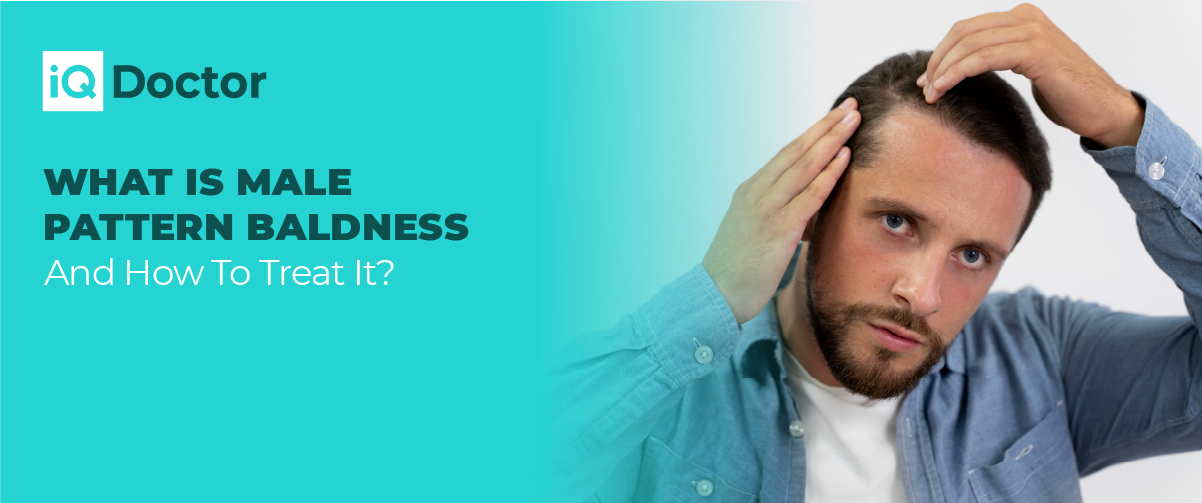What is Male Pattern Baldness, And How To Treat It?
21 March, 2022 | Jane Thomas - Marketing

Male pattern baldness is a hormonal and hereditary disorder that causes hair loss in men. It is the most common cause of male hair loss, and it affects men of all ages but is more common in middle-aged and older men.
Many men detect the early signs of male pattern baldness during their twenties and thirties, such as a receding hairline or scattered thinning. Male pattern baldness could be to blame if you have noticed that your hairline is receding.
Androgenetic alopecia is the scientific name for male pattern baldness. The presence of androgenic hormones, such as testosterone and dihydrotestosterone, along with heredity background, are the main reasons for male pattern hair loss. Contrary to popular opinion, male pattern baldness is not caused by factors such as wearing a hat or using non-organic shampoos and other hair care products.
It is natural to get concerned when you realise the onset of baldness. Luckily, there is a range of safe and efficient hair loss treatments available today that can help you preserve your existing hair, regrow your lost hair, and restore your self-esteem.
Symptoms of Male Pattern Baldness
Hair loss is the most noticeable symptom of male pattern baldness, but there are various ways male pattern baldness can manifest, from thinning of hair to a receding hairline.
Depending upon the types of male pattern baldness, you may not see excessive hair loss for some time and sometimes even go years without noticing any significant hair loss or changes to your hair pattern.
A receding hairline
The receding of the hairline marks the start of male pattern baldness, and it can lead to a distinctive M-shaped hairline, which features receding corners and a longer widow's peak area (known as the forelock).
The hairline does not recede in the same way for everyone. For some men, a receding hairline may occur evenly, whereas, for others, it may be patches of hair loss.
The thinning of the crown
If you're experiencing male pattern baldness, it’s not a given that you will have a receding hairline. Instead, as is the case for many men, the hair near your crown may begin to fall out and become thinner, whereas the rest may remain unaffected.
Since it isn't easy to notice hair loss at the crown of the head in the mirror, it is common for males experiencing crown thinning not to detect it until it is at an advanced stage.
A simple way to check for hair loss at the crown is to use a handheld mirror or take a selfie of the top of your head with your phone.
Diffuse thinning
Diffuse thinning is a type of hair loss that affects your entire scalp, thinning your hair without affecting your hairline in any way. Diffuse thinning is expected in male pattern baldness, although it is less common than a receding hairline or hair loss at the crown. This type of hair loss is usually the easiest to notice at the early stages, especially when your hair is damp or under bright lighting that makes parts of the scalp more visible.
What causes Male Pattern Baldness?
Male pattern baldness is primarily caused by a combination of two factors: (1) Your hair's susceptibility to androgenic hormones like dihydrotestosterone (DHT), and (2) Your synthesis of these hormones.
DHT is a natural androgen (male hormone) produced by your body. DHT is a byproduct of the sex hormone testosterone, which means that your body regularly transforms a small quantity of testosterone into DHT.
Getting a diagnosis of Male Pattern Baldness
To diagnose male pattern baldness, your doctor will most likely perform a dermoscopy to inspect your scalp for the extent of hair loss, the miniaturisation of your hair follicles, and the distance between each hair follicle.
Male Pattern Baldness Treatments
The sooner hair loss treatment for men is started, the better the chances of preventing hair loss. Medications like finasteride, which suppresses DHT, and topical medications like minoxidil, which encourage hair growth, are currently the most effective therapies for male pattern baldness. You will get the best results if you start using these treatments at the first sign of hair thinning or falling out.
Finasteride
Finasteride (the generic version of Propecia) is a hormone-based drug. It works by preventing the enzyme 5-alpha reductase from converting testosterone into DHT in your body. Finasteride can reduce DHT levels by 71.4 percent when taken as a hair loss prevention dose. Also, to the question about will finasteride regrow hair, the answer is yes. That is because, in addition to preventing hair loss, finasteride has also been shown to cause some lost hair to regenerate over time.
Minoxidil
Minoxidil (the generic version of Rogaine) is a topical hair-growth drug. It works by inducing the growth phase of your hair follicles, increasing blood flow to your hair, and assisting in transporting essential nutrients to your hair follicles. Unlike finasteride, minoxidil does not increase DHT levels and does not influence hormone synthesis.
Other Treatment For How To Stop Male Pattern Baldness
Hair transplant surgery
Hair transplant is a surgery that involves transplanting hairs from the back and sides of your head (areas normally not affected by male pattern baldness) to your crown, hairline, or other areas experiencing hair loss. A hair transplant surgery can virtually eradicate any visible symptoms of hair loss. Like most other cosmetic surgeries, hair transplant surgery can be costly, although the effective results can justify the price. However, it is recommended mainly for cases with advanced hair loss.
Micropigmentation of the scalp
Scalp micropigmentation is a cosmetic technique that alters the pigments of your scalp to give you the appearance of smaller, shorter hairs and a fuller head of hair. Although scalp micropigmentation can give the impression of thicker hair, it is not a cure for male pattern baldness and does not repair actual hair follicles.
Hairpieces
Hairpieces, weaves, and hair extensions for men-balding can be quite effective against hair loss. Hairpieces fill in thin patches and conceal hair loss when needed, even if they won't help you regrow any natural hair. These hairpieces are carefully personalised to the specifications of the individual scalp and blend in seamlessly. In addition, new forms of glue have been developed that are resilient to the elements, allowing you to move around without concern.
Reviewed By

Omar El-Gohary
The superintendent and lead pharmacist - registration number 2059792.
Omar is passionate about developing healthcare technology to empower our patients.


